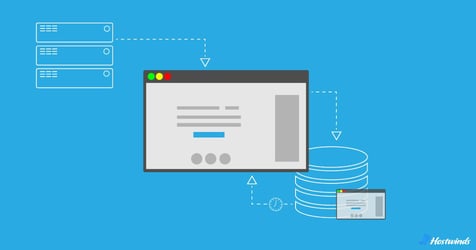Hostwinds Blog
Search results for:

What is Browser Cache and How Does it Work?
by: Hostwinds Team / November 28, 2023
In the ever-evolving landscape of web browsing, the unsung hero known as browser cache silently transforms the user experience.
Today's blog post aims to discuss browser cache—what it is, how it works, its role in enhancing website performance, the potential stumbling blocks site owners may encounter, and best practices.
What is Browser Cache?
Browser cache, often likened to a digital memory bank, is a temporary storage repository of frequently accessed static elements, such as images, HTML, CSS, and Javascript, on the user's device. This local storage enables browsers to retrieve these elements upon a user revisiting a website, alleviating the need for repeated downloads and providing a faster browsing experience.
How Does the Browser Know What to Cache?
The browser relies on several mechanisms within the HTTP header to decide what content is cache-worthy.
ETag (Entity Tag): An ETag is a unique identifier assigned to a specific version of a resource. When a user revisits a site, the browser checks if the ETag for a resource matches the stored ETag. If there's a match, the resource is still valid, and the cached version can be used.
Cache-Control Header: The Cache-Control header is a powerful tool for controlling caching behavior. Developers can specify directives, such as "max-age" to indicate the maximum time a resource is considered fresh, or "no-cache" to ensure the browser revalidates the resource with the server before using the cached version.
Expires Header: The Expires header is an older method to set a specific date and time when a resource expires. While effective, it lacks the flexibility of Cache-Control. If a resource's expiration date has passed, the browser fetches a fresh copy from the server.
Last-Modified Header: This header indicates when a resource was last modified on the server. When a user returns to a site, the browser can use the Last-Modified information to check if the cached version is still valid. If the resource has been modified since the last visit, the browser fetches the updated version.
Benefits of Browser Cache
When a user visits a site for the first time, the browser performs a DNS Lookup. This involves the browser contacting the web server, requesting site resources to populate for the user. The site's HTML loads first, which will tell the browser all the other resources it needs to request from the web server, including images, text, CSS, and Javascript. Each request takes time and uses bandwidth which affects both page speed and server load.
So how does caching help?
Faster Page Loading: Perhaps the most tangible benefit of browser cache is its contribution to faster page loading. Users experience a significant boost in speed, particularly during return visits, as the browser can retrieve and display cached content almost instantaneously.
Enhanced SEO Performance: Search engines often prioritize fast-loading websites, and by leveraging browser cache effectively, website owners can improve SEO rankings.
Reduced Server Load: Efficient use of browser cache alleviates the load on web servers. By serving locally cached content, servers experience fewer requests for the same resources, resulting in improved overall server performance.
Improved User Experience: Beyond the technicalities, the ultimate goal is to enhance the user experience. Browser cache, by making websites more responsive and quicker to load, contributes significantly to a positive and satisfying browsing journey.
Obstacles to Browser Caching
While caching is quite advantageous for users and website owners alike, improper management will undoubtedly lead to issues with user experience, security, and site performance.
Outdated Content: While the advantages of browser cache are evident, improper management can lead to the display of outdated content. Users might miss the latest updates on a website if old cached data takes precedence.
Compatibility Issues: In some instances, cached content may not seamlessly integrate with the latest changes made to a website. This can result in visual anomalies or functionality issues.
Security Concerns: While speeding up page loads, outdated security certificates or compromised cached content may pose security risks. Striking a balance between the benefits of browser cache and security considerations is paramount.
Best Practices for Managing Browser Cache
Let's explore a few caching tips that will can help set a site up for success and ensure a seamless user experience.
Set Proper Cache-Control Headers: Website owners wield the power to control how browsers cache content by setting precise Cache-Control headers. This strategic move defines the caching behavior of different assets, striking a harmonious balance between speed and content freshness.
Handle Cache Expiry and Validation: Establishing clear expiration times for cached content ensures users receive the latest updates. Adding validation mechanisms, such as ETag headers, helps browsers determine the validity of cached versions, promoting a dynamic and up-to-date user experience.
Utilize Cache Busting: Cache busting is employed to overcome the issue of browsers caching resources and displaying outdated content. By appending fingerprinting or version numbers to resource URLs, cache busting ensures that browsers fetch the latest versions, preventing users from experiencing stale or cached content.
Avoid Using Meta Tags for Caching: Using HTML meta tags to define cache behavior is not recommended because it lacks the granularity and flexibility offered by HTTP headers. HTTP headers allow developers to set detailed caching directives, whereas HTML meta tags provide limited control and may not be as effective in optimizing web performance.
Caching Out
As we walked through the intricacies of browser cache, we hope it becomes evident that its mastery is not just a technical skill but a gateway to unlocking a faster, more responsive web experience. By understanding the mechanisms, reaping the benefits, and navigating potential pitfalls, both developers and users contribute to a digital landscape that seamlessly balances speed with accuracy.
Written by Hostwinds Team / November 28, 2023
